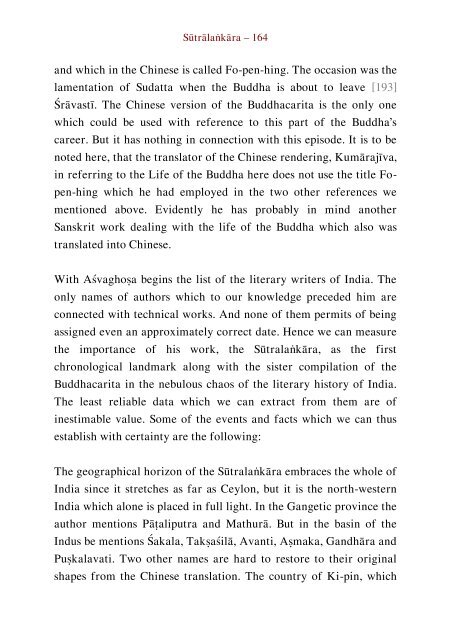Literary History of Sanskrit Buddhism
A study by J. K. Nariman of Sanskrit Buddhism from the Early Buddhist Tradition up to the Mahayana texts proper.
A study by J. K. Nariman of Sanskrit Buddhism from the Early Buddhist Tradition up to the Mahayana texts proper.
You also want an ePaper? Increase the reach of your titles
YUMPU automatically turns print PDFs into web optimized ePapers that Google loves.
Sūtrālaṅkāra – 164<br />
and which in the Chinese is called Fo-pen-hing. The occasion was the<br />
lamentation <strong>of</strong> Sudatta when the Buddha is about to leave [193]<br />
Śrāvastī. The Chinese version <strong>of</strong> the Buddhacarita is the only one<br />
which could be used with reference to this part <strong>of</strong> the Buddha’s<br />
career. But it has nothing in connection with this episode. It is to be<br />
noted here, that the translator <strong>of</strong> the Chinese rendering, Kumārajīva,<br />
in referring to the Life <strong>of</strong> the Buddha here does not use the title Fopen-hing<br />
which he had employed in the two other references we<br />
mentioned above. Evidently he has probably in mind another<br />
<strong>Sanskrit</strong> work dealing with the life <strong>of</strong> the Buddha which also was<br />
translated into Chinese.<br />
With Aśvaghoṣa begins the list <strong>of</strong> the literary writers <strong>of</strong> India. The<br />
only names <strong>of</strong> authors which to our knowledge preceded him are<br />
connected with technical works. And none <strong>of</strong> them permits <strong>of</strong> being<br />
assigned even an approximately correct date. Hence we can measure<br />
the importance <strong>of</strong> his work, the Sūtralaṅkāra, as the first<br />
chronological landmark along with the sister compilation <strong>of</strong> the<br />
Buddhacarita in the nebulous chaos <strong>of</strong> the literary history <strong>of</strong> India.<br />
The least reliable data which we can extract from them are <strong>of</strong><br />
inestimable value. Some <strong>of</strong> the events and facts which we can thus<br />
establish with certainty are the following:<br />
The geographical horizon <strong>of</strong> the Sūtralaṅkāra embraces the whole <strong>of</strong><br />
India since it stretches as far as Ceylon, but it is the north-western<br />
India which alone is placed in full light. In the Gangetic province the<br />
author mentions Pāṭaliputra and Mathurā. But in the basin <strong>of</strong> the<br />
Indus be mentions Śakala, Takṣaśilā, Avanti, Aṣmaka, Gandhāra and<br />
Puṣkalavati. Two other names are hard to restore to their original<br />
shapes from the Chinese translation. The country <strong>of</strong> Ki-pin, which


















